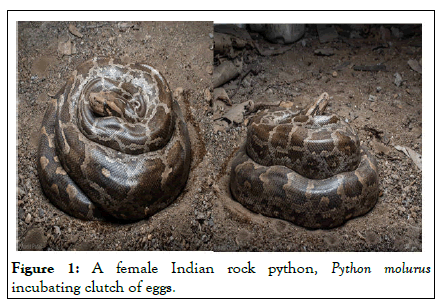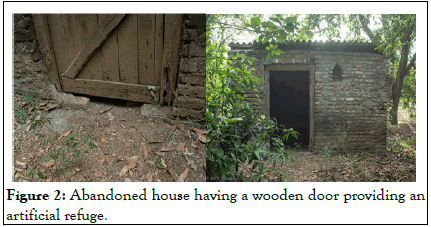Entomology, Ornithology & Herpetology: Current Research
Open Access
ISSN: 2161-0983
ISSN: 2161-0983
Short Communication - (2023)Volume 12, Issue 1
The intensification of human activities is responsible for the degradation of habitat which is the major cause of biodiversity regression. Snakes are generally highly secretive animals that spend a lot of time in shelters. Reptiles (lizards and snakes) have limited dispersal abilities and are consequently vulnerable to changes in habitat conditions. Urbanization and developmental activities by humans have led to the alteration of land use patterns and thus there has been degradation in the availability of natural habitats. Cold blooded animals are highly dependent on the presence of warm secretive spots for the purpose of their ecological requirements and regulating their body temperature. Here in we document a female indian rock python Python molurus incubating its eggs inside an abandoned old house. The dependency and resource utilization by animals on human habitations can be well presented through this documentation.
Artificial refuge; Predation risk; Incubating Indian rock python; Safer microclimate; Thermoregulatory behavior
A significant selective pressure influencing behavior is predation. Predation risk can be decreased by choosing refuges that provide reliable defense. Because of the close relationship between changes in body temperature and performance in ectotherms, the selection of microhabitats in reptiles is primarily influenced by thermal requirements. Reptiles must therefore maximise predator avoidance while decreasing thermal expenses in order to make the best use of their habitats. The capacity of individuals to choose safe and thermally appropriate shelters is a naturally selective behavior [1-6].
Urbanization and settlement expansions have been found to provide animals a place to live in urban habitats, despite the fact that it normally has a detrimental impact on wildlife. This also tends to increase the risks of interactions amongst both humans and animals and pose a significant threat. Due to their life history (limited dispersion capacity and home range) and physiological reliance on environmental factors like temperature and water availability, reptiles are typically vulnerable to habitat alteration. Therefore, compared to other vertebrates, reptiles are more vulnerable to hazards brought on by human activity.
Artificial buildings and infrastructure, which dominate urban landscape changes, can change the local microclimate, which directly affects a reptile's capacity to an age its physiological and behavioral processes. The quality of the breeding site may significantly influence reproductive efforts and breeding success in animals that actively maintain ideal conditions for offspring development. In accordance with the 2010 evaluation of the literature pertaining to the breeding biology of indian rock pythons based on the observations in captivity (Python molurus).
Herein we document an instance of an indian rock python, Python molurus incubating eggs in an artificial refuge (Figure 1) [7-10].

Figure 1: A female Indian rock python, Python molurus incubating clutch of eggs.
At about 14:00 hrs on 24th June, 2022, the first author discovered a female Indian Rock Python, Python molurus inside an abandoned house having a wooden door incubating a clutch of eggs in an abandoned house in Bhadeli (20°48'42.948''N, 73° 3'40.932''E), Gujarat, India. There could be a probable reason that this provided a safer and well thermo regulated artificial habitat amidst the human disturbances for incubating her eggs (Figure 2) [11-16].

Figure 2: Abandoned house having a wooden door providing an artificial refuge.
The snake was discovered by the local people. Throughout and after the documentation process the snake was left undisturbed as it was far away from human settlement place. We requested people to avoid visiting the site till the hatchlings are born and did a small awareness campaign.
We are thankful to Earth Crusaders organization for their social awareness on wildlife from grassroot level and helping in drafting of this manuscript and also thankful to Valsad Society for Prevention of Cruelty to Animals (VSPCA) for recording this documentation.
The authors declare no conflict of interest during the preparation of this article.
[Crossref] [Google Scholar] [PubMed]
[Crossref] [Google Scholar] [PubMed]
Citation: Patel A, Samal A, Pandey S (2023) Indian Rock Python Python molurus (Linnaeus 1758) Incubating in an Abandoned House in Bhadeli, Gujarat, India. Entomol, Ornithol and Herpetol. 12:292.
Received: 31-Aug-2022, Manuscript No. EOHCR-22-18751; Editor assigned: 02-Sep-2022, Pre QC No. EOHCR-22-18751 (PQ); Reviewed: 16-Sep-2022, QC No. EOHCR-22-18751; Revised: 03-Jan-2023, Manuscript No. EOHCR-22-18751 (R); Published: 16-Jan-2023 , DOI: 10.35248/2161-0983.23.12.292
Copyright: © 2023 Patel A, et al. This is an open-access article distributed under the terms of the Creative Commons Attribution License, which permits unrestricted use, distribution, and reproduction in any medium, provided the original author and source are credited.